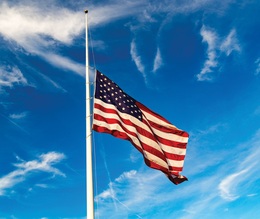
Nearly a quarter of a century ago, students, school communities and families across the country watched in horror as a once-anonymous town in Colorado erupted into a chaotic scene, with televised news broadcasting heartbreaking images of survivors clinging to one another in the aftermath of 1999’s Columbine High School shooting that claimed 13 innocent lives and left another 24 injured.
Almost instantaneously, sleepy suburban towns coast-to-coast grappled with the terrifying reality that any school could be next. With newly opened eyes that could scarcely believe what news clips and headlines made them witnesses to, school officials reassessed the security measures they once tacitly regarded as hypotheticals, regarding those proactive safeguards as the groundwork for life-saving measures in the suddenly too-possible likelihood of an unimaginable horror visiting their schools.
Twenty-four years later, “Columbine” is no longer the only name synonymous with gut-wrenching scenes of school violence as generations of students, academic employees and parents no longer know that privilege of taking school safety for granted: Lockdown drills, a visible police presence patrolling school grounds, entrances with multiply redundant checkpoints, student and faculty education ranging from desecration techniques to conflict-resolution training and always-evolving protective measures are just as entrenched in their daily routines as classroom lessons and extracurricular activities are.
There are some historical parallels to be drawn, however, suggesting that an academic education has always gone hand-in-hand with learning how to handle life-threatening scenarios when they intrude on the seeming sanctuary of a school environment.
“Years ago, when I went to grade school, I was hiding under a desk for a nuclear attack; now, the kids are worried about an active shooter,” says Michael Kantner, assistant vice president, emergency management coordinator at Rowan University and a 30-year law enforcement veteran. “But I’ll say this: We are very proactive in getting those trainings out to the Rowan community because we don’t want to be reactive. We want to be proactive because training and education are a major component, in my humble opinion, to trying to provide a safer environment for students and staff.”
And while it’s still hard to concede that we live in a world where these aren’t just rotely rehearsed drills interrupting a few minutes of class but rather developing muscle memory’s instinctive survival skills, the region’s school leaders note that emergency-situation preparedness and deterrents have been largely well-received.
“Safety and security is our primary focus and the primary responsibility of everybody who works in the district … academics is secondary,” notes Dr. Joseph Meloche, superintendent of Cherry Hill Public Schools, a 19-school preK-12 district. “For the most part, I can’t think of any specific instances recently where we’ve heard people speak against any of our safety and security measures—people will often talk about more steps to take.”
Security as Infrastructure and Information
Schools all throughout South Jersey are similarly and constantly reassessing the efficacy of their protective measures. Safety from an outside threat starts with the physical barriers, technology and policies ensuring that only students, faculty and approved guests can get past the main entrance and any other points of ingress.
“To get into our schools, you have to show identification, you have to have a meeting scheduled that’s known by the folks in the office, you have to be buzzed in to a vestibule, and then buzzed in again electronically to get into that building,” explains Jack McGee, interim superintendent for the 11 schools comprising Gloucester County’s Washington Township School District and a decades-long employee of the district.
There are human and technological eyes surveying both the interiors and exteriors of South Jersey’s schools, too, whether it’s during the academic day, during an evening board of education meeting, during an after-hours extracurricular event or days when class isn’t in session.
“In addition to what you would consider your normal security measures we have in place … we have surveillance cameras on all our properties so we can monitor the comings and goings of people,” says Dr. George Rafferty, superintendent of Mount Laurel Schools, a preK-8 district encompassing eight schools throughout the township. “We have a number of what I would call ‘hardscape’ security components built into our school architecture. Our partnership with the Mount Laurel Police Department also means that we have school resource officers who are assigned to our schools full time.”
Drills of all kinds are also routinely conducted, ranging from an active-shooter scenario to a bomb threat’s evacuation.
“We have those drills in place so we have that practice, so that the muscle memory of that protocol repeated over time is instilled in our students. We want them to have that confidence,” says McGee. “We also have a standard reunification method if, in fact, we ever had an incident in the district where we had to evacuate a certain building and then reunify our students with their families and parents.”
Districts tailor their safety plans, procedures and protocol to their specific community needs and building environments, though there are established guidelines they follow.
“We have plans in place that are required by the Department of Education’s Office of School Preparedness & Emergency Planning,” explains Anthony Saporito, director of security at the Cherry Hill school district. “That’s staffed by mostly retired state police and a couple career education representatives. They come up with the policies and procedures that we adhere to by the letter here in Cherry Hill. We follow every policy that comes down from the state that has to do with student, parent, administrative and staff security of the buildings, so we are at a high level of security every minute there are kids in our buildings.”
“Since Columbine occurred, our security has been increasing dramatically,” Dr. Meloche adds, citing a few examples of school-day security currently in place throughout the district’s buildings. “First and foremost, exterior doors are locked at all times … During the course of the academic day, the main entrance is the only place that the community members, families, parents, people can get into the building. We utilize electronic access for our staff members to get into the building, we have protocols with our school classroom doors being locked at all times and expedient ways to secure them from the inside of the classroom.”
It’s not just K-12 districts that are revisiting and revising their safety plans. With colleges being inherently more entrenched in and accessible to the communities they call home and sprawling well beyond a single building or two to include numerous far-flung locations, ensuring the safety of a university community requires some additional reinforcement and assistance from a range of supportive entities.
That’s why simplifying safety training can be an invaluable tool, especially when school safety training is an inherently repetitive cycle that starts anew with each incoming class.
“I use a term, I call it ‘the four R’s’: Repetition reinforces retention and recall,” Kantner explains. “The more you repeat something, whether it’s attending trainings or security awareness, repetition reinforces it, it engrains in you better. And then you retain it so you can recall it if, God forbid, you need to use it.”
An Increased Police Presence
“Police officers in our buildings act as a deterrent,” says McGee. “The presence of officers in our schools, including our elementary schools, is absolutely and unequivocally welcomed by our faculty, by our principles, by other leaders in the building and absolutely by our parents. They are an absolute welcome addition to our staffing.”
McGee has more than 40 years’ experience in education and has seen how today’s schools have to keep revising, revisiting and modernizing their safety efforts as new threats emerge, new potential weak spots are identified so campuses can responsively tighten their security just a little bit more.
“After Columbine, our relationship and partnerships with the Washington Township Police Department/the mayor’s office/the Washington Township Town Council—because that’s a unified group—changed and we started putting police officers in schools shortly thereafter,” he recalls. “I was the principal at Washington Township High School at the time, and the local police and the district had placed a couple officers there, and we’ve had two police officers ever since, five days a week from the first day of school until the last day.”
He continues: “In addition to those two school resource officers at the high school, we now have something called special law enforcement officers (SLEOs) … and we have one at each middle school, and then we have another four among our seven elementary schools. And then we’ll have another three SLEOs in the fall so that by September of 2023, we’ll have a school officer in every single school. … The officers, in addition to being a presence there, work with students in classrooms and become integrated into the school environment on a daily basis, so they’re in classrooms, they’re in libraries, they’re in meetings with students, they have special programs so that our students become aware of the value of having their local officers, who they see in their community, in their buildings every day.”
Washington Township isn’t alone in welcoming dedicated law enforcement officers on school property, reflecting a philosophical shift in how schools see the roles they play in terms of protecting their community’s youngest members.
“We’re the only school district in the state of New Jersey that has its own police department,” says Saporito. “We have nine officers that are deployed strategically across the district … The campus police officers, our main focus is being part of the community: We are 100% dedicated to our campuses, and what makes my guys most effective is their ability to create relationships.”
Dr. Rafferty explains that dedicated Mount Laurel Police Department officers are a constant feature at the district’s eight schools, who are there to not only establish trust in their young charges but also participate in safety drills.
“During every one of those drills that we run in each of our schools, our school resource officers partner with the principal and they’re part of the drill,” he says. “The police officer observes, participates and they make notes, and then they share feedback with the principal about what went well about the drill, what could be improved. Hopefully, by doing these things regularly, we’re staying in a state of readiness in case a real emergency occurs.”
Interpersonal Education and De-escalation Training
Beyond drills, another facet of hands-on training is making a proactive difference within the school community. Increased faculty training, as well as anti-bullying education, mental-health support and a focus on empathy are helping to keep day-to-day student altercations and interpersonal issues from escalating into heartbreaking, headline-making tragedies, since a threat to the school community at large doesn’t always come from an outside force.
After all, early intervention to keep emotional and behavioral issues in check is one way to “address small issues before they become huge ones that are difficult to resolve or address,” Dr. Rafferty observes. The key, he notes, is to focus on preventative support rather than punitive measures that may make an already emotionally vulnerable child feel further vilified or victimized.
“We utilize a program called ‘Handle With Care,’” he continues. “It’s a de-escalation training program … and all of our principals and administrators get trained in Handle With Care strategies and practices to show them how to de-escalate individual students or a conflict between students. … We run those workshops and training sessions annually, and we’re constant;ly refreshing people’s training in that program.”
After all, as Dr. Meloche observes, it’s attentive eyes and ears that ensure the successful evolution of any school-security efforts. Making sure a district’s families are just as engaged and informed as the students and staff filling school buildings with life every day is a critical component in being attuned to issues that could be brewing both inside and beyond each school.
“Human beings truly are the most important part of any comprehensive safety plan,” he says. “They’re the best part of it. We try to make sure this is something that we talk about and we bring attention to on a regular basis within the school facility. Any time there’s a drill within our buildings, the building principals send an email or a message home to families letting them know there was a drill today, this is what we did, this is what we practiced so they can talk about it and ask their children about it.”
It Takes a Village
Parent, faculty, student and community feedback are all taken into consideration as South Jersey’s school districts regard their safety and security measures not as rigid protocols but rather living plans that need to adapt and evolve as responsively as modern developments demands.
“Our leadership team, our faculty, our parents and our board of education all, I think, support the efforts that we’ve had and all have a role in our annual review and improvements to our protocols,” says McGee.
“The safest schools,” addsDr. Rafferty, “are where everyone works together.”
That team effort and community-wide dedication to protecting everyone inside our schools is what it takes to ensure that children’s most basic safety needs are met so that they’re able to learn and grow in an environment where their overall well-being is everyone’s main focus.
“People will ask questions if we’ve considered everything from arrival and dismissal to lockdown drills within the school, where do kids go, are all the doors secured and securable, that kind of thing,” Dr. Meloche adds. “We are entrusted with the best part of our community and the most important part of our community, which are these children. That’s why safety and security always have to be that top priority.”
Because, while we can’t control what each new day will bring, we do have the resources and experts at the ready to minimize our chances of becoming a victim.
“I tell parents flat-out: Anything can happen anywhere, any time, any place in the world,” Kantner says. “When you send your kids off to school, you want them to get a quality education in a safe place. That’s why we’re very big on increasing our resources to be that safe environment, and also provide that safety education to our students.”
Click here to subscribe to the free digital editions of South Jersey Magazine
To read the digital edition of South Jersey Magazine, click here.
Published and copyrighted in South Jersey Magazine, Volume 20, Issue 1 (April 2023)
For more info on South Jersey Magazine, click here.
To subscribe to South Jersey Magazine, click here.
To advertise in South Jersey Magazine, click here.












